
First published in the July 2016 issue of Wheels magazine, Australia's best car mag since 1953.
New baby Holden Sparks a $15K battle with crisp class fave Suzuki Celerio and spicy newcomer Kia Picanto.
WHY do kids want to grow up so fast? In no time they’re adults, and there’s no way back to the days of carefree youth.
A similar mindset afflicts carmakers. Take the latest Barina (please!). Once the feisty “beep-beep” baby of Holden’s 1980s line-up, today it’s nearly two sizes larger and half a tonne heavier, but also about half as much fun.
In 2010, Holden introduced a smaller Barina ‘Spark’ to fill the gap at the bottom of its line-up, but this rough little appliance simply made the real Barina look better value. This time, however, we’re promised that the second-generation Holden Spark out of Korea (but via Holden’s Lang Lang Proving Ground finishing school) has matured rather than merely changed.
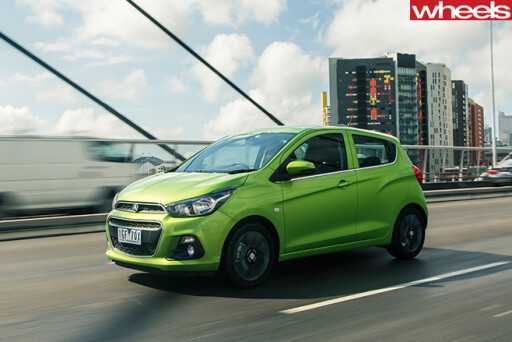 Nearly identical in most dimensions except height, the lower yet roomier sub-B micro hatch ditches the confusing Barina prefix. Though it is claimed to be brand new, beneath the pleasantly proportioned if somewhat prosaic exterior is a significant evolution of GM’s versatile Gamma platform that underpins everything from the Opel Corsa and Chevrolet Trax to the Fiat Punto and Jeep Renegade.
Nearly identical in most dimensions except height, the lower yet roomier sub-B micro hatch ditches the confusing Barina prefix. Though it is claimed to be brand new, beneath the pleasantly proportioned if somewhat prosaic exterior is a significant evolution of GM’s versatile Gamma platform that underpins everything from the Opel Corsa and Chevrolet Trax to the Fiat Punto and Jeep Renegade.
A much stronger body for improved dynamics and reduced NVH (central to the previous Spark’s sorrows) is just the beginning; a fresh 1399cc naturally aspirated four-cylinder engine, Holden’s first continuously variable transmission (replacing an old four-speed auto) and heavily Australianised suspension, steering, and drivetrain calibrations also accompany the Lion cub’s road to newfound maturity.
The genesis of this comparison was during COTY testing at Lang Lang last year, when Holden senior vehicle dynamics engineer (and Nurburgring ute lap record holder) Rob Trubiani reckoned the then-upcoming Spark would be a game-changer. He had just witnessed each of the eight judges returning – some with giant grins – after a stint in one of our favourite micro contenders, the Suzuki Celerio.
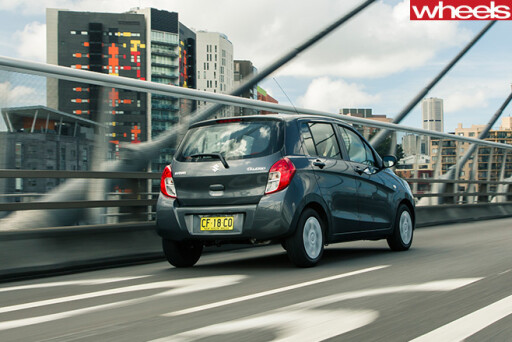 A few months later, Wheels contributor Ash Westerman’s first drive review of the new baby Holden declared it as having graduated from “class dunce to dux”.
A few months later, Wheels contributor Ash Westerman’s first drive review of the new baby Holden declared it as having graduated from “class dunce to dux”.
The battle of the babies was on!
Suzuki’s dowdy yet delightfully obedient Celerio was released in early 2015 amid international controversy over a brake-pedal bracket that was worryingly prone to breaking. It was quickly rectified and the Thai-built Japanese hatch dodged a scandal, while its plain styling became easy to overlook because it was roomy, refined, fun and only $13K driveaway.
Our third contender, the Kia Picanto, is new to Australia but already five years old elsewhere and due for replacement soon. Belatedly arriving here in only one specification, the Picanto Si is a 1.2-litre automatic priced at $14,990 driveaway.
 Like the others, the Picanto offers Bluetooth phone and audio streaming, power windows, electric mirrors, remote central locking, a trip computer and a temporary spare. But then it blitzes with standard four-wheel disc brakes (rare even in the class above), rear parking sensors and an industry-leading seven-year/unlimited-kilometre warranty with roadside-assist and fixed-price servicing (versus three years/100,000km for the rest). Boom!
Like the others, the Picanto offers Bluetooth phone and audio streaming, power windows, electric mirrors, remote central locking, a trip computer and a temporary spare. But then it blitzes with standard four-wheel disc brakes (rare even in the class above), rear parking sensors and an industry-leading seven-year/unlimited-kilometre warranty with roadside-assist and fixed-price servicing (versus three years/100,000km for the rest). Boom!
No wonder Kia is confident it can sell 300 a month, or about 40 percent of the total segment, while luring potential used-car buyers. Ambitious stuff.
The $14,490-driveaway Celerio auto’s $500 advantage over Picanto is diminished by having only a four-star ANCAP crash test rating (mainly due to an average pedestrian-impact result), as well as this test’s sole four-seat configuration.
 Even though the Spark LS CVT from $15,690 (before on-roads) costs about $1700 more than the Kia by the time you drive away from the showroom, it misses out on rear electric windows, map pockets and back-seat cupholders. However, the Holden alone offers a central touchscreen with apps connectivity, voice recognition and Apple CarPlay/Android Auto smartphone-mirroring tech. For some people, this would be the deal-maker. And a rear-view camera and cruise control are optional, as is an up-spec LT auto model for $18,990.
Even though the Spark LS CVT from $15,690 (before on-roads) costs about $1700 more than the Kia by the time you drive away from the showroom, it misses out on rear electric windows, map pockets and back-seat cupholders. However, the Holden alone offers a central touchscreen with apps connectivity, voice recognition and Apple CarPlay/Android Auto smartphone-mirroring tech. For some people, this would be the deal-maker. And a rear-view camera and cruise control are optional, as is an up-spec LT auto model for $18,990.
Such features accentuate how sophisticated the Spark’s cabin is for this segment, starting the moment a hefty door thuds closed. With a large central touchscreen, big-car dash layout, sturdy materials and pleasing finish, it seems Germanic in essence, as if Opel rather than Chevrolet dictated the interior.
Gone is the old car’s messy ‘motorcycle-inspired’ analogue/digital instrumentation cluster-fudge, replaced by conventional yet classy dials. Plenty of thought clearly went into the switchgear layout, the three-spoke wheel is of Commodore quality and the driving position benefits from the arrival of seat-height adjustment.
 The new Spark is also pleasingly spacious, with plenty of room for four (or five if you’re a skinny kid), sitting on comfy outboard seats offering sufficient thigh and backrest support. However, a lofty rear cushion and curving roofline limits headroom for beanpoles.
The new Spark is also pleasingly spacious, with plenty of room for four (or five if you’re a skinny kid), sitting on comfy outboard seats offering sufficient thigh and backrest support. However, a lofty rear cushion and curving roofline limits headroom for beanpoles.
Annoyances include the lack of an auto-down driver’s electric window (Picanto and Celerio both have it), wind-down rear windows and a small glovebox, as well as instruments that reflect sunlight, central vents hell-bent on freezing hands, zero back-seat storage and a parcel shelf that doesn’t flip down automatically when you close the rear hatch – an infuriation when you get back in, glance in the mirror and see cardboard where a window should be.
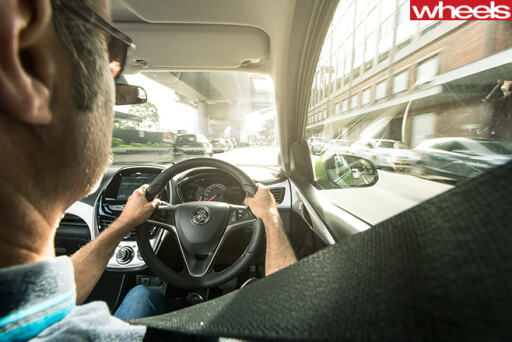 Picanto may be the oldest design here but it’s nevertheless modern in an agreeable Euro/Asian fusion way. The wavy dash’s driver-oriented presentation adds a certain engaging cosiness. Save for the confusing audio/Bluetooth interface, the Kia hardly puts a foot wrong ergonomically. Crisp dials, overhead grabhandles for all passengers, the group’s only front seatbelt height adjusters and a well-angled rear backrest further advance the Kia’s cause.
Picanto may be the oldest design here but it’s nevertheless modern in an agreeable Euro/Asian fusion way. The wavy dash’s driver-oriented presentation adds a certain engaging cosiness. Save for the confusing audio/Bluetooth interface, the Kia hardly puts a foot wrong ergonomically. Crisp dials, overhead grabhandles for all passengers, the group’s only front seatbelt height adjusters and a well-angled rear backrest further advance the Kia’s cause.
It is therefore doubly disappointing to discover sub-par audio quality, a misaligned dash speaker cover and some rattly door trim at speed, undermining the Picanto’s quality. We’re also disappointed with the poor front-seat thigh support and lack of door storage, but we can accept that, as a city-car, rear legroom is limited, especially with three adults in the back.
The opposite is true of the Celerio, which was designed to be the roomiest sub-B runabout ever, aided by the longest wheelbase and highest roof here. Which makes the decision to offer only four seats a wasted opportunity.
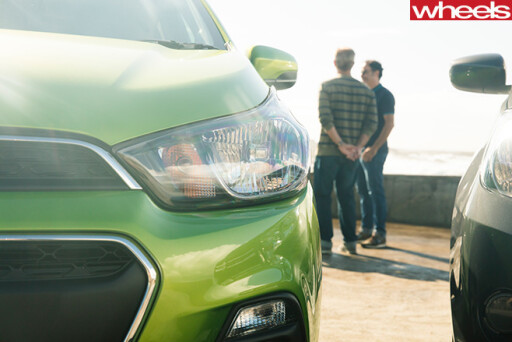 A massive glasshouse and thin pillars make the Suzuki a cinch to manoeuvre in tight places. Its seats, driving position and logical control layout are the best here for long-distance comfort, and the dash is elegantly minimalist yet functional, with easily read instruments and fat-finger-friendly switchgear. There’s no shortage of storage, the back seat feels expansive and, although the cushion doesn’t flip forward, the extra height liberated by its tall-boy styling provides heaps of cargo versatility.
A massive glasshouse and thin pillars make the Suzuki a cinch to manoeuvre in tight places. Its seats, driving position and logical control layout are the best here for long-distance comfort, and the dash is elegantly minimalist yet functional, with easily read instruments and fat-finger-friendly switchgear. There’s no shortage of storage, the back seat feels expansive and, although the cushion doesn’t flip forward, the extra height liberated by its tall-boy styling provides heaps of cargo versatility.
Celerio downsides include front headrests that protrude too far forward, rattles that were apparent in our test car, plenty of noise intrusion at highway speeds, and a dated Bluetooth connectivity set-up that proves confusing.
None of these three hatches feature Autonomous Emergency Braking – even though the Volkswagen Up did so as standard in 2012 – or reach-adjustable steering, a digital speedo or cruise control.
 The newest engine of the group is the Spark’s. Its 73kW/124Nm 1.4-litre all-aluminium four with variable valve timing is an eager performer in the low-to-mid rev ranges, thanks in part to the artificially stepped CVT auto’s willingness to be in the right ratio at the right time. Consequently, standing-start acceleration builds strongly and maintains momentum smoothly until the tacho hits about 5500rpm, when the engine begins to sound a bit thrashy. Peak power is at 6200rpm, but is best avoided.
The newest engine of the group is the Spark’s. Its 73kW/124Nm 1.4-litre all-aluminium four with variable valve timing is an eager performer in the low-to-mid rev ranges, thanks in part to the artificially stepped CVT auto’s willingness to be in the right ratio at the right time. Consequently, standing-start acceleration builds strongly and maintains momentum smoothly until the tacho hits about 5500rpm, when the engine begins to sound a bit thrashy. Peak power is at 6200rpm, but is best avoided.
A 10.8sec sprint to 100km/h makes Spark the quickest here, and those extra cubic centimetres deliver dividends on a flat or straight road. Introduce corners or hills, however, and the CVT’s relative laziness is telling, taking its time downshifting to a lower ‘gear’. And there’s no manual over-ride for the driver to assume control.
More significant for a city-car is economy. Despite being 4kg lighter than the 994kg Kia, the Holden’s thirst proved worrying, guzzling 98-octane brew (though it can run on 91RON) at 8.5L/100km – a litre more than Picanto and 2.4L/100km worse than the Celerio. If this is the best a so-called all-new chassis and powertrain can achieve, then it’s not good enough, GM.
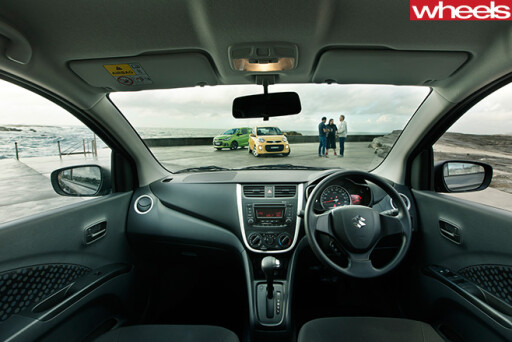 The Spark’s result would be less disheartening if it trounced the others in acceleration and refinement, but there’s not much in it against the 63kW/120Nm 1.2-litre Picanto, whose ageing four-speed torque-converter auto threw one of the comparo’s biggest curveballs.
The Spark’s result would be less disheartening if it trounced the others in acceleration and refinement, but there’s not much in it against the 63kW/120Nm 1.2-litre Picanto, whose ageing four-speed torque-converter auto threw one of the comparo’s biggest curveballs.
Quiet and polished pottering around town, the Kia automatic shuffles between ratios unobtrusively, providing sufficient oomph when needed to thrust quickly through tiny traffic gaps. Even when floored, the Picanto punches harder than its modest spec would suggest.
Away from urban confines, its lack of capacity and gears is more noticeable, and here the Holden charges away. But all the Kia driver has to do is pull the lever down to third or second and the trannie will hold each ratio to the redline, making the most of the available power to keep the Spark in sight. Transformative and involving, it adds a delightful manual dimension lacking in the others. Call it an oldie but a goodie.
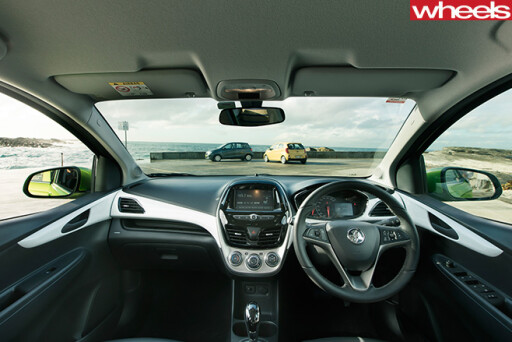 With only 50kW and 90Nm from its 998cc atmo triple, the best we could wring out of the bluff and boxy Celerio at the track was 13.4sec to 100km/h. But decent low-down pull, a propensity for the CVT to hold on to higher revs to keep the car in the sweet spot, and a 130kg weight advantage mean the Suzuki is quite tenacious. So long as you don’t mind the constant drone of the trannie in full flight, it doesn’t hang about.
With only 50kW and 90Nm from its 998cc atmo triple, the best we could wring out of the bluff and boxy Celerio at the track was 13.4sec to 100km/h. But decent low-down pull, a propensity for the CVT to hold on to higher revs to keep the car in the sweet spot, and a 130kg weight advantage mean the Suzuki is quite tenacious. So long as you don’t mind the constant drone of the trannie in full flight, it doesn’t hang about.
A bit more feel and response from the Celerio’s slightly doughy steering would be appreciated, but it is ridiculously easy to drive quickly, has a very tight turning circle, and irons out urban bumps with almost French-car suppleness.
While there isn’t really enough power to alter the chassis’ composure on faster rural roads, the steering firms up nicely and turns in faithfully while the car feels planted. But Celerio’s ride deteriorates on rough roads and its cabin starts to sound like a wasp in an empty drum. Raw, noisy fun.
But not as much fun as the Picanto, which turns it up a notch around town in terms of steering feel and reactivity, with a naturally composed attitude. It moves a bit more on its suspension over bumps but remains comfortable.
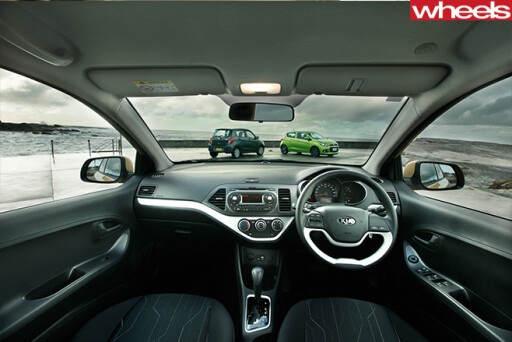 Where the Kia really has the power to surprise is away from the city, where it feels sharp, light and eager to change direction – seemingly sometimes from behind, before the stability control intervenes. Reflecting its European tune, the Picanto is set up for enthusiasts. With the auto lever in manual mode, it can be a giggle over a curvy stretch. You’ll even forgive its occasional jittery ride.
Where the Kia really has the power to surprise is away from the city, where it feels sharp, light and eager to change direction – seemingly sometimes from behind, before the stability control intervenes. Reflecting its European tune, the Picanto is set up for enthusiasts. With the auto lever in manual mode, it can be a giggle over a curvy stretch. You’ll even forgive its occasional jittery ride.
Holden tuned and honed the Spark on Australian roads to the point where it behaves more grown-up than either rival, or any sub-B hatch on the market, and on a number of fronts. Its steering is responsive yet linear and full of feel, resulting in poised and secure roadholding, and just as impressive is its ability to soak up bad surfaces, especially around town. The change is profound over the preceding version, though road noise can be intrusive.
What’s missing from the Spark is verve and – ironically – sparkle. You can scoot along a snaking B-road and totally rejoice at what Trubiani’s team has achieved dynamically, but there’s a lack of adjustability to the chassis that makes it seem a bit dull. A muted charm.
Nevertheless, Spark pushes class boundaries for steering, handling, ride and refinement. But we’re a bit disillusioned by its slightly underwhelming drivetrain performance, its relative thirst and various spec anomalies. While it wins this fight, the winning margin should be greater.
The opposite is true of the Picanto, which punches well above its weight for fun and feistiness, then backs that up with refinement, economy and outstanding value. Well done, Kia. It nips at the Holden’s heels like a lovable terrier.
A respectable third (rather than last) is where the Celerio lands. Save for a boomy cabin and four-seat configuration, it continues to charm with its frugality, huge interior, lively performance, sorted handling and excellent inner-city ride. Its virtues are truly its own.
While newfound maturity has seen a baby Holden win a Wheels comparison test for the first time in forever, it shouldn’t be in too much of a rush to outgrow youthful exuberance – something the Kia and Suzuki possess in spades.

COMMENTS